News
The sharks of Tiger Beach
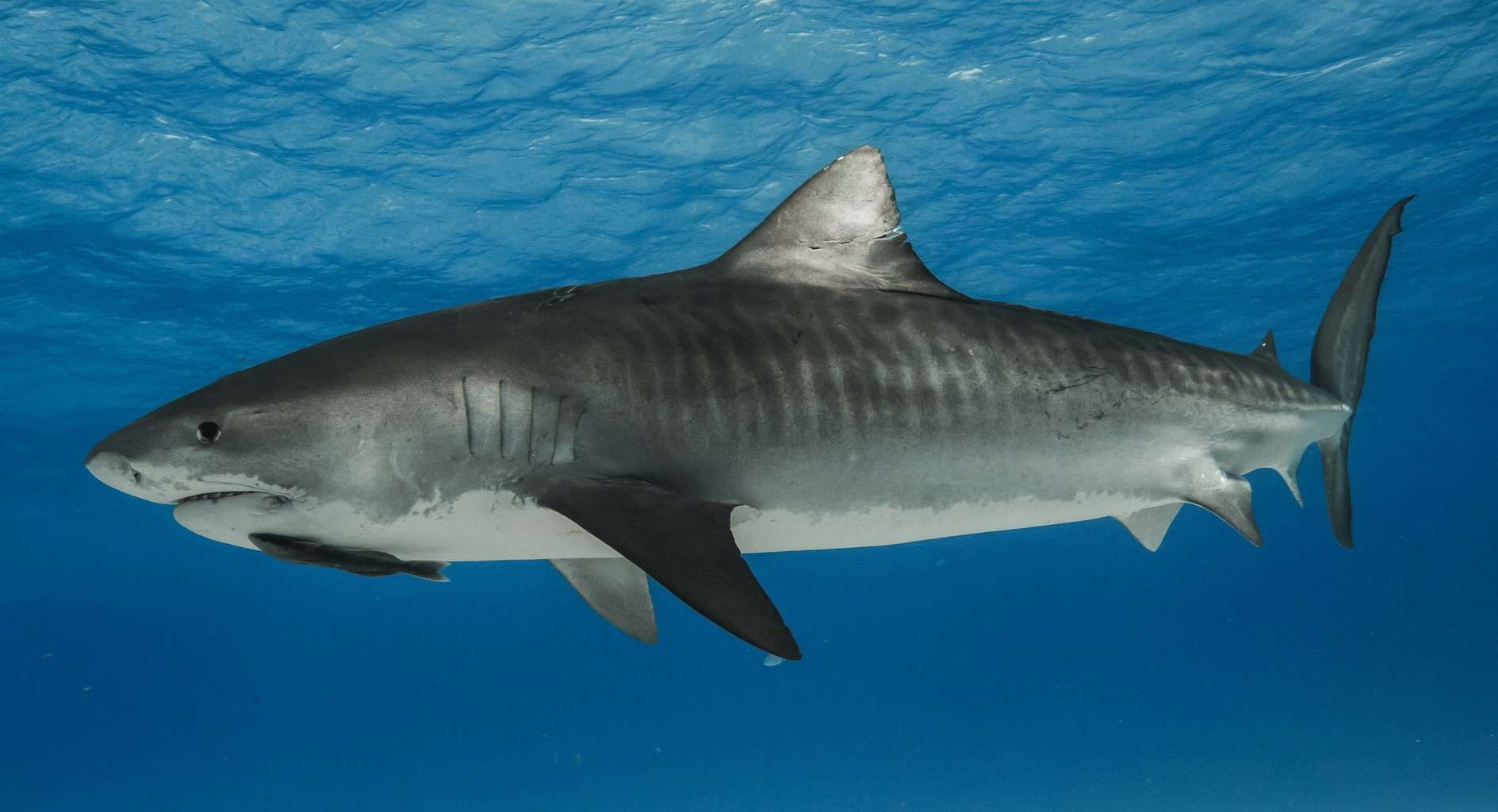
“When ‘Tiger Beach’ is ON – it’s the world’s greatest shark dive.“ – Eli Martinez, Shark Diver Magazine
I kneel on the ground of a sandbar in six meter depth in the Bahamas in crystal clear water, visibility about 30 meters. In front of me are roughly 20 lemon sharks. With a length of about three meters, the “lemons” are quite impressive. If you dive with them for the first time, you might feel a bit uncomfortable, because these sharks do not know anything like a safety distance. They partially patrol past the divers at arm’s length. After a couple of dives, a kind of acclimatization takes place and the frequent, almost obtrusive shark encounters leave me more relaxed. Still it seems I have to clarify the right of way with them. Just keep your composure, I tell myself.
In general, lemon sharks are considered not particularly aggressive, but whoever thinks they are completely harmless, should have a talk with Al Brenneka. The head of the “Shark Attack Survivors” was attacked by a lemon shark. He was surfing at Delray Beach in Florida in November 1976. He lost his right arm, both lung wings collapsed and he spent three days in coma – but he survived the attack. Nevertheless, the lemon sharks look like impetuous ruffians.
I wait for the real infamous bats – the tiger sharks! The tiger of the sea is a generalist and eats everything. Even cement bags have been found in the stomachs of tiger sharks, as well as car signs, preserves, rubber tires and plastic bottles. And, of course, people! Recently, a large female tiger shark named “Emma” has even been caught carrying the camera of a diver away – partly with the diver still dangling onto it. Maybe she has a deal with an Ebay dealer, who knows.
“Tiger Beach” is more or less a huge, kilometer-wide sandbar. The pleasant thing is that this dive site is very shallow and easy to dive with a maximum depth of twelve meters, so that increased air consumption can be attributed exclusively to an increased adrenaline level. Why they call this place a “beach” is not quite clear to me – there is no beach to lie on. The word was coined by big-game fishermen who hunted tiger and lemon sharks here.
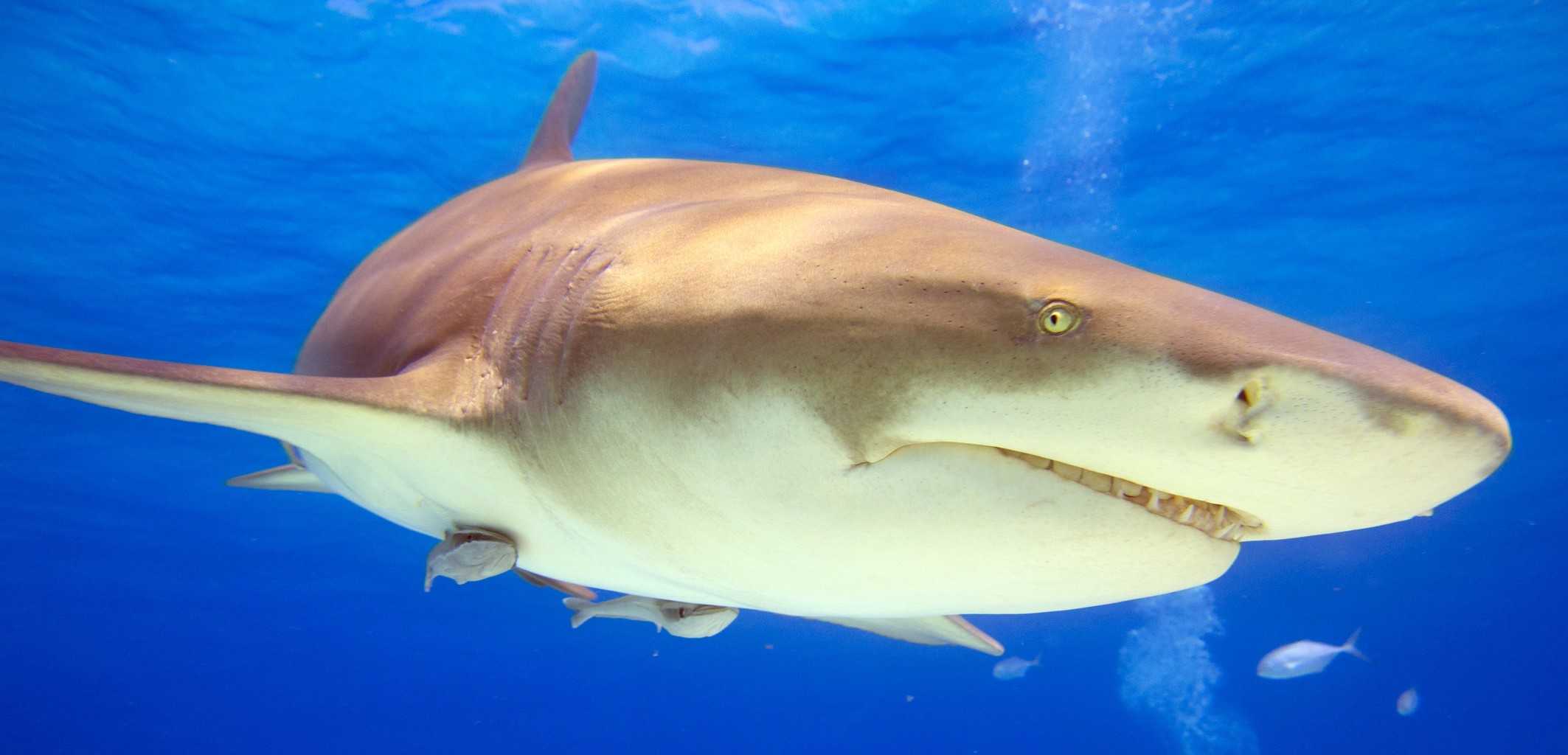
Suddenly the sky darkens as a great shadow falls upon me. Have clouds obscured the sun? I look up and recognize a five meter tiger shark, weighing about 1,000 kilos! Goosebumps crawl over my body, because I know what that means – “Emma” is here! Who the hell gave this floating leviathan the cute little girl’s name “Emma”, I wonder? The shark is huge, with an incredible circumference, and she acts like an oil tank in a bathtub. Now the circus begins. But this is not a circus, this is Emma’s hunting area! Stories of gruesome shark attacks on people belong to the Bahamas and the Caribbean waters just like pirate stories. To put it precisely, sharks not only kill people, they also eat them. With skin and hair including wet suit. Only the compressed air bottle remains from divers, maybe even the respiratory regulator. But don’t count on it. The headlines hit me again:
- In 2008 the Austrian lawyer Markus Groh was killed by a shark.
- In 2011 the famous shark whisperer Jim Abernathy himself was attacked and only barely survived.
- In July 2014 the 63-year-old physician Dr. John Petty died during a night dive at Tiger Beach. Only his diving equipment was found later – with clear bite marks!
- And in January 2015, 34-year-old Lacy Webb Martin was severely bitten in the back while snorkeling at Tahiti Beach off Abaco Island not far away.
The islands of the Bahamas look like a chain of precious jewels that are dipped on a surface of more than 13,000 square kilometers of the clear, tropical ocean at the tip of the Caribbean. Wherever you look, blue coves illuminate and you see aspirin white beaches. Of the more than 700 Bahamas islands, only 30 are inhabited. The Bahamas consist of the islands and more than 2,400 coral reefs, the so-called “Cays”. The island group got its name by the Spanish conquerors. They called the waters around the islands of Baja Mar (Spanish for ‘shallow sea’), which later became Bahamas.
My journey takes me to Grand Bahama island with the 15 meter long sailing yacht “Bye Polar” from Miami. It is one of the northernmost islands of the Bahamas and is located about 90 km off the coast of Florida. Here you have some beautiful beaches to choose from including imaginative names like Xanada Beach, Taino Beach, Fortune Beach or Gold Rock Beach. An access road on Grand Bahama leads past the “Pirates of the Caribbean” film locations. For 3,000 Euro I sleep a week on less than two square meters next to two snoring Americans, share a shower and a loo with seven passengers and two crew members, and eat frozen cakes with spray cream. I still do not think about the price for a second. For this money, they bring you back alive. And I do not like to gamble with my life. After all, I have a wife and two kids – what the hell am I doing here? Is this a normal diving vacation or do I play Russian roulette with the devil?
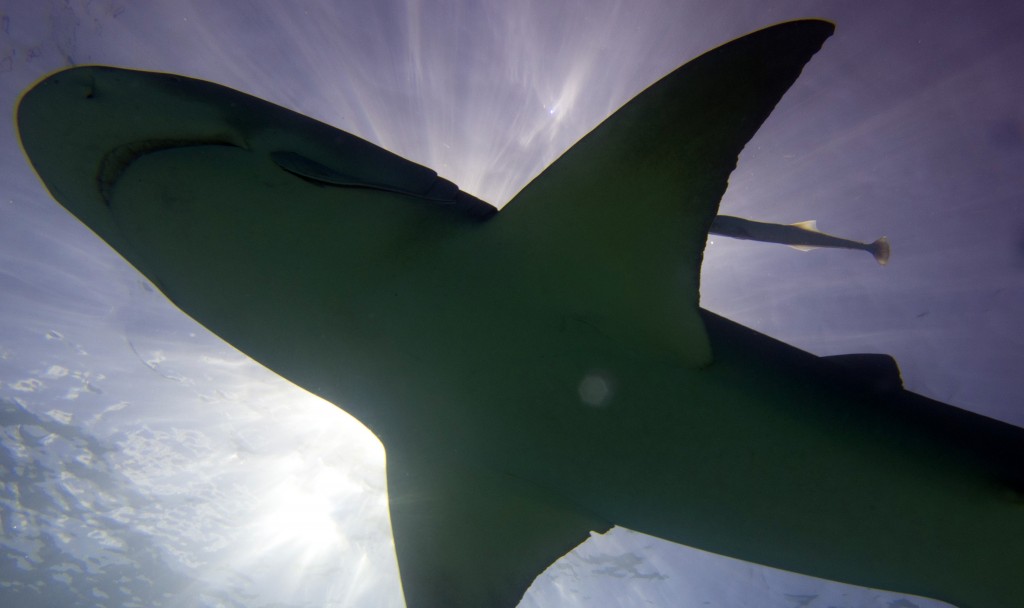
Clownfish, seahorses and spanish dancers stand high in the favor of many divers. But honestly: for really exciting dives the nice little stuff is rather unsuitable. Every now and then you need some adrenaline. There is plenty of it when a giant top predator approaches you to within a few centimeters. What a “normal citizen” would call naked horror, provides some divers with a big kick.
Big hammerhead sharks can be seen in the Bahamas rather in the winter months, tiger sharks, lemon sharks and Caribbean reef sharks all year long, longimani (oceanic white tip sharks) on special tours in spring, and bull sharks from September to June. In order to lure the sharks to the vicinity of the boat, you need to chum the water which means you put a large box with dead fish into the water. Every diver has to be aware of the fact that the sharks are hoping for food around the boat and that they must adhere to strict rules of conduct to keep the risk of attacks as small as possible! Since the dive sites are all off the mainland, you sometimes get tricky currents and other difficult diving conditions. All participants have to bring a well-founded diving experience – but above all you should be so easy with diving that you can focus on the sharks. Apart from “diving” with the famous great whites in South Africa or Australia, you dive without cage. It is important that everyone is aware that diving with large sharks is never risk-free. In addition, all liability exclusions must be signed against the boat company.
We are passing several dive sites. The actual highlight of this trip is, however, the absolutely spectacular dive site Tiger Beach. The place is by its very nature an absolute El Dorado for photographers and filmmakers who receive spectacular templates for stunning pictures and sequences en mass.The news that the first tiger shark is now swimming down there has frightened all the guests from the lunch table. Now it is frantic on the dive deck of the “Bye Polar”, because this is the moment all the guests have waited for. The dive crowd is curious on the platform and let their eyes wander. Only the silhouettes of the lemon sharks are clearly visible. Fifteen or a few more might be there now. A lemon shark can be easily recognized by its second dorsal fin, which, unlike other shark species, is almost as large as the first fin. Lemon sharks are big and mean-looking and appear in dire need of an orthodontist. Their spiky teeth are very much in evidence. They’re very much like the sharks in Finding Nemo.
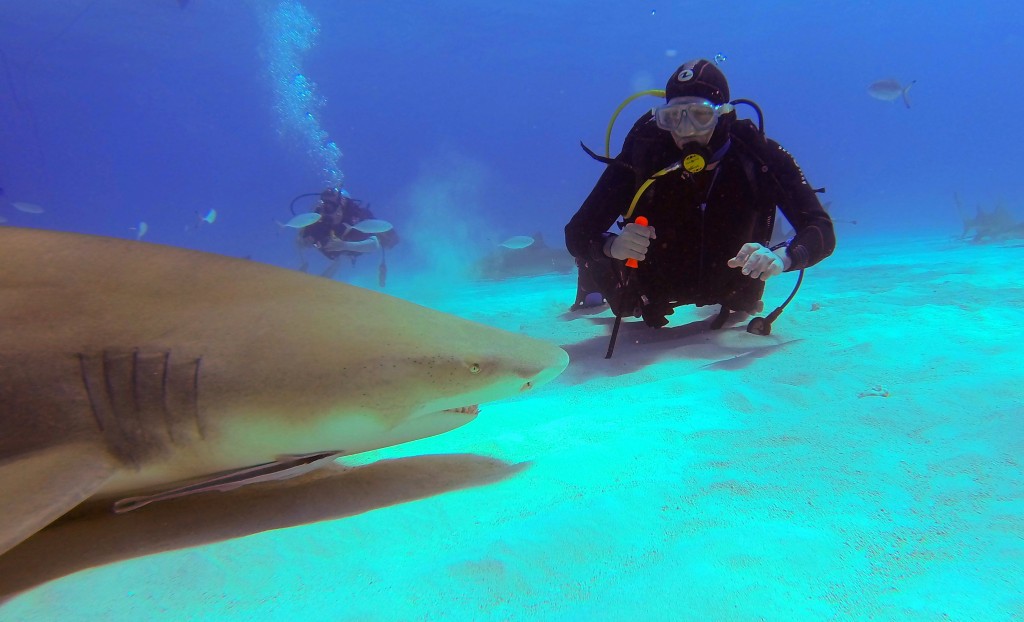
Even at the last dive after breakfast, a real clump of shark bodies formed around the perforated bait box. The dead fish in it are not reachable for the sharks and so they circle around and get excited, always the smell of blood in the nose. Slowly the guests glide into the wet suits. Everyone is looking into the water. Still no trace of the tiger. The first encounter with the tiger shark was, of course, the subject on board, ever since the ship left Coconut Grove.
Just before the big leap, everyone was a bit queasy. The inner tension could be felt. Hardly anyone said a word and the smiles had disappeared. Then it was time to descend directly to the bottom. The current had been somewhat overloaded and was carrying a lot of suspended particles.Thus, the visibility deteriorated significantly. We squeezed down in a semicircular formation around the bait box. A handsome number of “Lemons” circled around the box and between the divers. However, there was still no sign of a tiger shark. Our guide, Martin, floated to the food box and opened it for a brief moment. Some small chunks were carried away by the current. Immediately movement came into the pack. Due to the fast movements close to the ground, much sediment was swirled up, which further deteriorated the visibility. He opened the basket one more time and released a few appetizers.Then the tiger appeared.
It was as if she came from out of nowhere: Slowly, and without any hustle and bustle, the tiger shark swam between the lemon sharks towards the bait box, very close to Martin. She was big, really respectably big. The eyes of the divers were still fixed on her. After a few laps around the bait box, she passed the full length of the group.
Again she took course for the bait box. Martin took a big fish head out. Without changing its speed, the tiger aimed toward the bait. A lemon shark took its chance; it was slightly faster and snapped the fish head. The tiger bumped into him and wanted to grab the competitor. The lemon shark immediately dropped the bait. This clearly shows who the boss was at the lunch table.
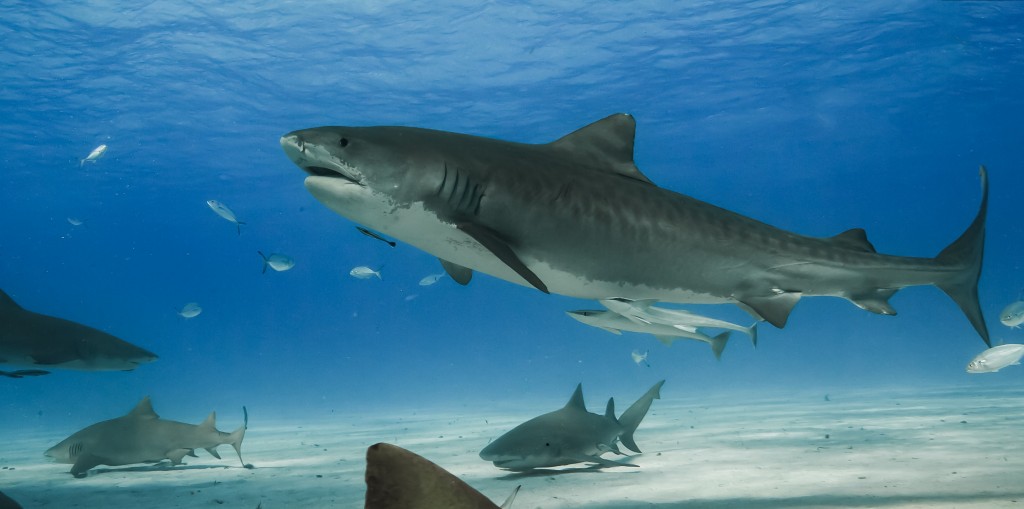
Photo: Benoit Raoul
Martin continued to play the game for a while. The powerful shark swam a few larger circles and sometimes disappeared because of the bad visibility. Suddenly, however, she appeared again. She scrutinized the bubbling creatures, but her distance decreased further. Not even 50 centimeters separated the tiger shark from the first diver of the group. His adrenaline level certainly reached a peak.
Slowly the colossus moved on, directly across some heads of the group. When she was almost out of sight, the gestures of the divers indicated what is going on in their heads – that was close. Later on, on board, when the nerves slowly reached the normal range, everyone had very happy faces.
Shortly before the dive we had seen a few dolphins from the boat. Where dolphins are, there are no sharks around. That’s what they told us in “Flipper”. This thesis is often rejected.
The next dive: The tiger shark approached the bait rather slowly and carefully. Bustle was not her thing. The movements were slow, but she was purposeful. When an audacious lemon shark snatched the bait out of the tiger shark’s jaws, the pack went into rage. Only a fraction of a second later she clamped her huge jaws into the back of the lemon shark. A loud cracking sound could be heard as if someone broke off a rotten branch in the forest. The battered Lemon Shark swam away, presumably with a broken neck, if indeed he even survived the attack. Ubruptly I was aware that the law of the strongest is dominating below. And the law is the tiger shark.
Shark experts call him the “bad guy”, a villain of the seas. Tiger sharks are considered to be the most dangerous predators in the tropics. It has the most perfect and at the same time the most horrifying bite of all sharks. Its bite strength is so great that it can crack any turtle shell with ease.
Do you ever wonder how we have any sea turtles left in our oceans? Surely as the years have passed these slow moving tasty morsels of goodness would have nearly all be consumed by the more agile and powerful shark. I mean really, other than a hard shell (which tiger sharks have little problem sawing through with their well suited teeth), what chance do sea turtles have? Well, it turns out, sea turtles have some clever defenses that they use to help avoid being taken by a shark.
Firstly, when approached by an inquiring shark, the sea turtle will often present its full, flat shell towards the shark. Instead of being horizontal like a flat cookie which the shark can easily bite through, it will stay in a half-roll type position and the shark will not be able to open its mouth wide enough to bite into the large broad surface of the shell.
Secondly, the turtle will stay very close to the shark and will keep swimming in a tight circle around it. The shark will not be able to match the tight radius and thus will not be able to latch onto the turtle.
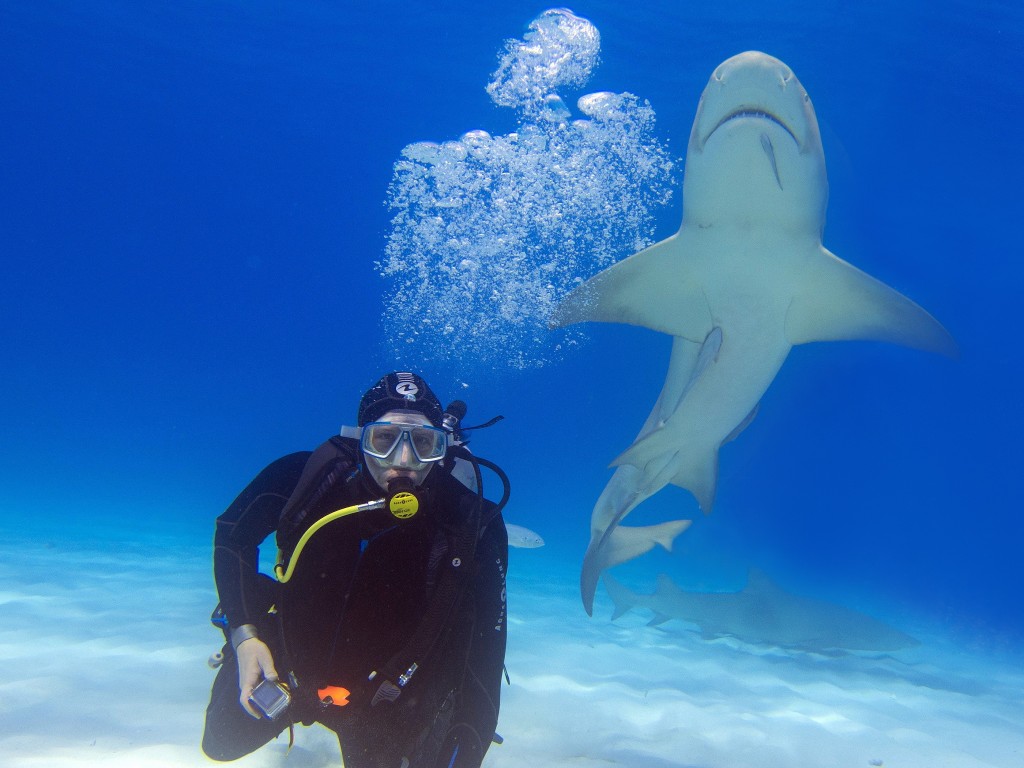
Tiger sharks are no food specialists such as white sharks, who prefer hunting seals and tuna fish. They examine everything that swims and floats as if it is food. The wide food spectrum allows the tiger shark to survive in all seas. He is particularly successful in hunting large waterbirds such as albatros. Unlike the great whites, tiger sharks are not threatened with extinction. Tiger sharks can pose a danger for swimmers and bathers. His predilection to rise from the depths at dawn and dusk to go hunting make evening bathing trips an incalculable risk. Snorkelers are also threatened:
It was the 14th of August 2013 when the 20-year-old Jana Lutteropp from Germany went swimming off the beach of Makena on Maui. Suddenly the serenity was gone. A huge shadow shot to the surface and separated her right arm with a bite near the shoulder. California teacher Rick Moore and his friend Nicholas Grisaffi heard the mark-shrieking screams, jumped into the water and pulled the blood-rushed young woman ashore under the eyes of shocked passers-by. “I’m dying, I know I’m dying,” Lutteropp said in the rescue operation. A few days later Jana did die of her serious injuries in the hospital. On the basis of the cleanly cut wound and the tooth tracks, sharks experts concluded the attack was by a tiger shark about 3m long.
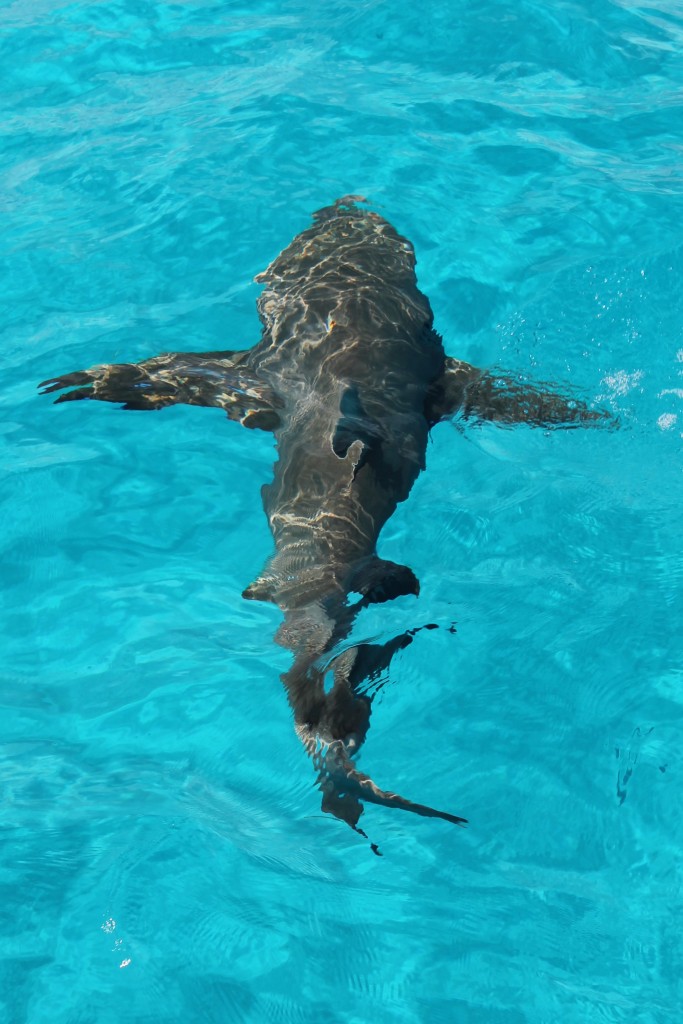 The tiger-like striped pattern, at which the hunter can easily be recognized, fades with age. Divers who encounter a tiger shark should not panic. The dangerous animal is rather shy and reserved towards divers. As a rule, you can keep him in check with a stick or a large camera – but must have good nerves. In particular, don’t let them push you towards the water surface – the so-called “death zone”. There, the tiger shark loses all inhibitions.
The tiger-like striped pattern, at which the hunter can easily be recognized, fades with age. Divers who encounter a tiger shark should not panic. The dangerous animal is rather shy and reserved towards divers. As a rule, you can keep him in check with a stick or a large camera – but must have good nerves. In particular, don’t let them push you towards the water surface – the so-called “death zone”. There, the tiger shark loses all inhibitions.
The calm and leisurely buoyancy of the massive cartilaginous fish should not conceal the fact that it can achieve an astonishing acceleration with emphasis and endurance. Tiger sharks are considered to live in coastal waters, but they also regularly cover vast distances. A team from the “Guy Harvey Research Institute” of the “Nova Southeastern University” in Florida discovered this. They studied a total of 24 tiger sharks with satellite transmitters in Bermuda and pursued their migration for three years. They found out that the area around Bermuda is something like a tiger shark highway. Here they collect their energy and then swim further north or south. They spend the winter in Caribbean waters (Bermuda, Bahamas, Turks and Caicos Islands, Anguilla) and mate. In the spring, they travel north into the open Atlantic Ocean as high up as Connecticut. On their round trip some of the marked sharks covered a distance of 7,500 kilometers.
Tiger sharks often appear completely unexpected and especially from behind. They are ambush predators. Therefore, the whole group should not only keep an eye on the food box, but also ensure a 360-degree check. This becomes all the more important the more of the big predators appear at Tiger Beach. Nevertheless, a close-up encounter with a tiger shark is one of the most exciting things you can experience as a diver. When diving with the Great White Shark, all participants usually sit in a safe cage. This is absolutely impossible because of the topography at Tiger Beach. No cage, no safety, just water and sharks. That’s why Tiger Beach is “Diver’s first choice for Tigersharks”.
For centuries, tiger sharks were the ultimate horror for all sailors. Twenty years ago no one would have imagined diving with them – even voluntarily. It was in the spring of 1998, when Jim Abernethy sought shelter on a sandbank of the “Little Bahama Bank” on the occasion of a rising storm with his ship “Shearwater”. The next morning Jim and his crew saw great shadows glide through the turquoise water. A hastily performed dive revealed a small sensation. Five tiger sharks were seen. The precipitous descent ended fortunately without bruises and Jim recognized his chance to create something unique. It was the birth of Tiger Beach, a shark arena in the waters of the Bahamas.
The bottom is fine sand, the particles of which can be perceived as floating particles by the presence of divers and sharks in larger numbers. The visibility may be difficult. We were mostly lucky and appreciated it at 20 – 30 m.In the afternoon there is a regular current which, although it distributes all truffles, makes it more difficult to keep a spot. The low depth is ideal, because you do not have to worry about diving time and you are also fast on the platform. If you should dare to emerge fast, the tiger sharks react immediately and follow you to the platform. Sometimes with open mouth. This boosts the adrenaline supply.
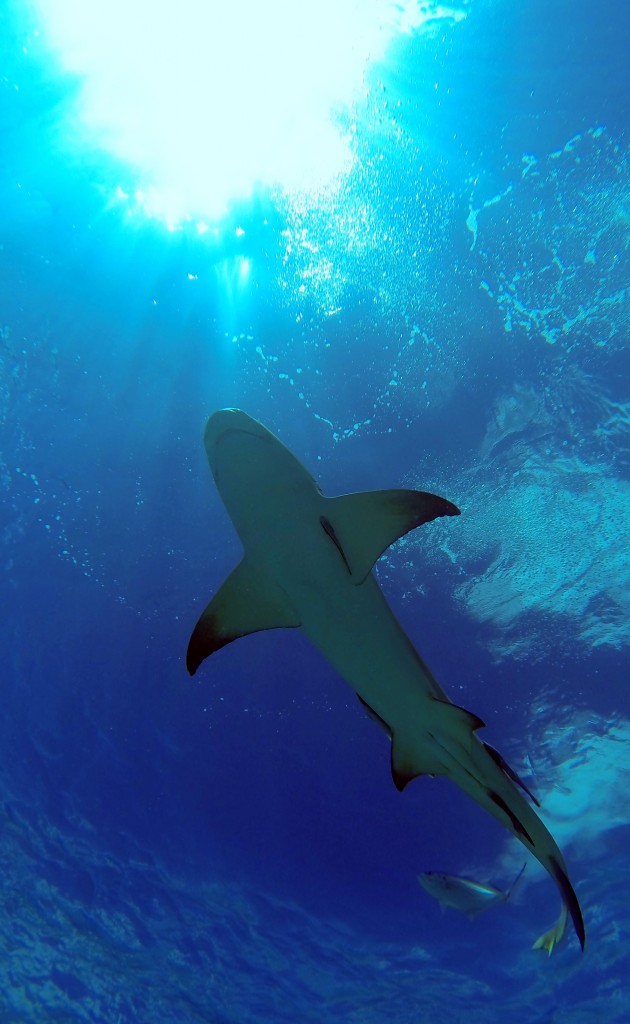
Diving with tiger sharks is unquestionably something special. The great predators are rightly regarded as risk factors, because their reactions can never be predicted in every detail. A gambler’s game with an uncertain exit. Or not. Because if you manage the business with the tigers of the sea, everything looks simple and calculable. But is it really? A somewhat queasy feeling comes when you slide into the green blue water for the first time. You could probably photograph tiger sharks by luring them to the boat with bait boxes largely without danger. If an attractive bait is missing though, you might turn into bait yourself, and then it could get uncomfortable. A real attack is hard to survive. Our guide, Martin, has his eyes everywhere, but you have to be alert yourself all the time.The situation is controllable when there are about two to three tiger sharks, but with more it becomes critical, because the sharks are also approaching from behind, and want to examine the divers for feasibility. When the white naked skin of the eyes swings upward, extreme caution is required. Then at least a test bite is bound to happen. The bite attempts, although not considered as serious attacks, are nevertheless hellishly dangerous. The giant, triangular teeth of the tiger sharks tear ugly and possibly fatal wounds even in a test bite, because you cannot estimate how the lemon sharks swimming in groups will behave with blood in the water; and secondly, the nearest hospital is a few hours’ boat trip away. Even if you survive the bite in the water, the chances of getting away unharmed are minimal. That disaster at Tiger Beach is omnipresent has been proved by the deadly attacks on Markus Groh and Dr. John Petty!
To ensure that the adventure takes place safely, Martin has developed his own precautions and rules: the suit, the mask, the fins and the jacket should be covered in dark or pale colors. Although one is not sure whether tiger sharks can see colors, Martin is of the opinion that everything that is yellow, white, pink or silvery is a no-go, because it might encourage the predator to investigate. I leave my jewelery and my yellow snorkel on board. I look a bit confused when some of us get neon yellow and aluminum colored oxygen bottles! In addition, we get about 50 cm long, cut off PVC pipes to keep the sharks at a distance. When it’s my turn to get one, the pipes are out. Great! Instead, Captain Levente puts a 30 cm screwdriver into my hand – with a bright orange handle. How was that again with the renouncement of bright colors?
Some tiger sharks have been feeding regularly for years and have names like “Emma”, “Hook” or “Tarantino”. Others only come occasionally. A critical moment is always the ascent to the boat platform. You should only do it if there is no tiger shark in the immediate vicinity. They always follow to the platform. There were several hairy situations, which we could not interpret 100% afterwards. Had the tiger shark bitten if he had caught the legs or the fins? Martin agreed, but was also not sure if the bite would have been conducted with consistency. Perhaps it would have been just a test. But that would have at least been a run for the hospital – or even for the casket.
The basic question is: Why can you as a diver usually go safely into the realm of the sharks and why are people sometimes attacked? Dr. Erich Ritter found in field trials with bull sharks in the Bahamas that three criteria must be fulfilled that tempt a shark to attack a human being:
- The smell
- The noise
- Poor visibility
On the first attempt, Erich Ritter waded chest-deep into the sharks in clear water and fed them with pieces of meat. Although the smell of food was in the water, they did not attack him because two other points were not fulfilled: he did not make any noise and there was good visibility. In the second experiment, he swam between the sharks and thus caused the sounds of a fish in distress. But there was also no attack, as there was still good visibility under water. Had he been swimming in turbid waters, his pale legs might have reminded them of the bright belly of a prey, which could have motivated the sharks to attack. Only if all three criteria were met, this could trigger an attack, according to Ritter.
My time in the Bahamas is coming to an end. I’ve seen a lot of sharks. Many. The Bahamas have understood that it is worth protecting them and making them a good source of income. A lively treat for divers and photographers. My conclusion? The Bahamas are full of beauty, nature, and adventure. Even in the low season a sunny paradise beyond mass tourism. The big sharks like to go through here. And I too will return.
All photos by Christian Kemper unless otherwise stated.
[hr style=”single”]
 You can purchase Christian’s book, ‘Strange Pool Friends – Mein Freund, der Hai’, here.
You can purchase Christian’s book, ‘Strange Pool Friends – Mein Freund, der Hai’, here.
Gear News
Introducing the TR-80, IR-50 and CS-30 Regulators from DYNAMICNORD

Whether you are a beginner or a professional diver – with the three new main regulators from DYNAMICNORD, everyone will find their favourite regulator. They all look super stylish.
Excellent performance with the TR-80
Quality and performance are the be-all and end-all for regulators. It is not for nothing that the TR stands for Tec Reg. The innovative design of the TR-80 guarantees absolute reliability – even in ice-cold waters.

Perfect breathing effort at 0.8 J/l / certified for diving in waters below 10 degrees / structural design made of solid brass for best cold protection / membrane-compensated design with dry seal of the first stage / reduced exhalation effort thanks to optimized exhalation membrane and bubble deflector / adjustable Venturi (dive/predive) and adjustment knob for individual inhalation comfort / innovative design of the front cover prevents free-flow in strong currents or when diving with scooters / design made of sandblasted brass, matt chrome finish / 2 HP and 4 LP outlets / mouthpiece made of high-quality, anti-allergic silicone for maximum comfort.


Amazing underwater adventures with the IR-50
The IR-50 is the top regulator for advanced and experienced divers. Natural breathing is the essence of this regulator.

Ideal breathing effort at 0.8 J/l /certified for diving in waters below 10 degrees / compensated membrane / adjustable venturi (dive/predive) and adjustment knob for individual inhalation comfort/ outlet valve and deflector for minimum exhalation effort and reduction of bubbles on the face / design made of sandblasted brass, matt chrome finish / 2 HP and 4 NP outlets / mouthpiece made of high-quality, anti-allergic silicone for maximum comfort.


The Workhorse – our CS-30
For diving centres and diving beginners – the workhorse stands for strong construction, reliability and robustness. Perfect for your training.

Optimal breathing effort at 0.8 J/l /recommended for diving in waters above 10 degrees / non-compensated piston / adjustable venturi (dive/predive) / outlet valve and deflector for minimum exhalation effort and reduction of bubbles on the face / design made of sandblasted brass, matt chrome finish / 1 HP and 3 NP outlets / mouthpiece made of high-quality, anti-allergic silicone for maximum comfort.


Octopus OP-30
The OP-30 is the ideal addition to all DYNAMICNORD regulators. It is identical in construction to the CS-30.

The TR-80, IR-50, CS-30 (DIN & INT) regulators and the Octopus OP-30 are available from DYNAMICNORD dealers and in the online store.
DYNAMICNORD – Your Outdoor Companion.
Marine Life & Conservation
Paul Watson Released as Denmark Blocks Japan’s Extradition Bid

Renowned anti-whaling activist Paul Watson has been released from custody in Greenland after spending five months in detention. Denmark’s Justice Ministry rejected Japan’s request for his extradition, citing insufficient guarantees that his time already served in custody would be credited against any potential sentence.
The 74-year-old Canadian-American was arrested on July 21 in Nuuk, Greenland’s capital, when his ship docked to refuel. His arrest was based on a 2012 Japanese warrant related to a 2010 encounter in Antarctic waters. Japan alleged Watson obstructed operations and caused damage to a whaling research ship during efforts to disrupt illegal whaling. Watson has consistently denied these claims, maintaining his commitment to marine conservation.
Denmark, which oversees extradition matters for Greenland, concluded that while the legal conditions for extradition were met, the lack of assurances from Japan regarding time-served credit made extradition untenable.
In a video shared by his foundation, Watson expressed gratitude and relief, saying, “After five months, it’s good to be out… and good to know they’re not sending me to Japan.” He added that the most difficult part of his time in custody was being separated from his two young sons.
Watson is a pioneering figure in marine conservation, known for founding the Captain Paul Watson Foundation in 2022 after decades of activism with the Sea Shepherd Conservation Society. His bold efforts to defend marine life have earned him widespread support, including from celebrities and conservationists. His work has also been featured in the acclaimed reality TV series Whale Wars.
Watson’s lawyer, Jonas Christoffersen, praised the decision, stating, “We are happy and relieved that Paul Watson is now free.” He added that Watson is eager to reunite with his family and continue his vital work.
The arrest occurred while Watson’s vessel, the M/Y John Paul DeJoria, was en route to the North Pacific with a team of 26 volunteers to intercept a Japanese whaling ship. His foundation described the arrest as politically motivated and emphasized that Watson’s actions were focused on ending illegal whaling practices.
Japan resumed commercial whaling in 2019 after leaving the International Whaling Commission, asserting that whale meat is a cultural tradition. Conservationists, however, continue to challenge these practices, highlighting their impact on marine ecosystems.
Despite the challenges, Watson remains steadfast in his mission to protect marine life and bring attention to whaling practices. His dedication to ocean conservation has made him a globally respected advocate for the environment.
-

 News2 months ago
News2 months agoIconic SS United States to become the World’s Largest Artificial Reef
-

 News3 months ago
News3 months agoBook Review – 52 Assignments: Underwater Photography
-

 Gear News3 months ago
Gear News3 months agoDYNAMICNORD – New German diving brand enters the British market
-

 News3 months ago
News3 months agoExploring Cenote El Pit: A Diver’s Dream
-

 Gear News3 months ago
Gear News3 months agoTry BARE drysuits (and maybe even win one!) this Friday with Sea & Sea at North West Dive Fest
-

 Marine Life & Conservation3 months ago
Marine Life & Conservation3 months agoBook Review: Coral Triangle Cameos
-

 Blogs2 months ago
Blogs2 months agoDive the Egyptian Red Sea this Autumn with Regaldive
-

 News3 months ago
News3 months ago2024 Ocean Art Underwater Photo Competition Announced















